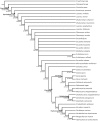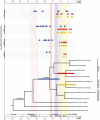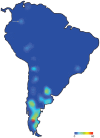Major radiations in the evolution of Caviid rodents: reconciling fossils, ghost lineages, and relaxed molecular clocks
- PMID: 23144757
- PMCID: PMC3483234
- DOI: 10.1371/journal.pone.0048380
Major radiations in the evolution of Caviid rodents: reconciling fossils, ghost lineages, and relaxed molecular clocks
Abstract
Background: Caviidae is a diverse group of caviomorph rodents that is broadly distributed in South America and is divided into three highly divergent extant lineages: Caviinae (cavies), Dolichotinae (maras), and Hydrochoerinae (capybaras). The fossil record of Caviidae is only abundant and diverse since the late Miocene. Caviids belongs to Cavioidea sensu stricto (Cavioidea s.s.) that also includes a diverse assemblage of extinct taxa recorded from the late Oligocene to the middle Miocene of South America ("eocardiids").
Results: A phylogenetic analysis combining morphological and molecular data is presented here, evaluating the time of diversification of selected nodes based on the calibration of phylogenetic trees with fossil taxa and the use of relaxed molecular clocks. This analysis reveals three major phases of diversification in the evolutionary history of Cavioidea s.s. The first two phases involve two successive radiations of extinct lineages that occurred during the late Oligocene and the early Miocene. The third phase consists of the diversification of Caviidae. The initial split of caviids is dated as middle Miocene by the fossil record. This date falls within the 95% higher probability distribution estimated by the relaxed Bayesian molecular clock, although the mean age estimate ages are 3.5 to 7 Myr older. The initial split of caviids is followed by an obscure period of poor fossil record (referred here as the Mayoan gap) and then by the appearance of highly differentiated modern lineages of caviids, which evidentially occurred at the late Miocene as indicated by both the fossil record and molecular clock estimates.
Conclusions: The integrated approach used here allowed us identifying the agreements and discrepancies of the fossil record and molecular clock estimates on the timing of the major events in cavioid evolution, revealing evolutionary patterns that would not have been possible to gather using only molecular or paleontological data alone.
Conflict of interest statement
Figures







Similar articles
-
Arrival and diversification of caviomorph rodents and platyrrhine primates in South America.Syst Biol. 2006 Apr;55(2):228-44. doi: 10.1080/10635150500481390. Syst Biol. 2006. PMID: 16551580
-
Diversification and biogeography of the Neotropical caviomorph lineage Octodontoidea (Rodentia: Hystricognathi).Mol Phylogenet Evol. 2012 May;63(2):417-29. doi: 10.1016/j.ympev.2012.01.020. Epub 2012 Feb 8. Mol Phylogenet Evol. 2012. PMID: 22327013
-
Biogeography in deep time - What do phylogenetics, geology, and paleoclimate tell us about early platyrrhine evolution?Mol Phylogenet Evol. 2015 Jan;82 Pt B:358-74. doi: 10.1016/j.ympev.2013.12.002. Epub 2013 Dec 12. Mol Phylogenet Evol. 2015. PMID: 24333920
-
The Paleogene fossil record of birds in Europe.Biol Rev Camb Philos Soc. 2005 Nov;80(4):515-42. doi: 10.1017/S1464793105006779. Biol Rev Camb Philos Soc. 2005. PMID: 16221327 Review.
-
On the age of eukaryotes: evaluating evidence from fossils and molecular clocks.Cold Spring Harb Perspect Biol. 2014 Aug 1;6(8):a016139. doi: 10.1101/cshperspect.a016139. Cold Spring Harb Perspect Biol. 2014. PMID: 25085908 Free PMC article. Review.
Cited by
-
Phylogenetic congruence, conflict and consilience between molecular and morphological data.BMC Ecol Evol. 2023 Jul 5;23(1):30. doi: 10.1186/s12862-023-02131-z. BMC Ecol Evol. 2023. PMID: 37403037 Free PMC article.
-
Late middle Miocene caviomorph rodents from Tarapoto, Peruvian Amazonia.PLoS One. 2021 Nov 3;16(11):e0258455. doi: 10.1371/journal.pone.0258455. eCollection 2021. PLoS One. 2021. PMID: 34731166 Free PMC article.
-
Comprehensive total evidence phylogeny of chinchillids (Rodentia, Caviomorpha): Cheek teeth anatomy and evolution.J Anat. 2021 Aug;239(2):405-423. doi: 10.1111/joa.13430. Epub 2021 Mar 15. J Anat. 2021. PMID: 33721329 Free PMC article.
References
-
- Brochu CA (1997) Morphology, fossils, divergence timing, and the phylogenetic relationships of Gavialis . Systematic Biol 46: 479–522. - PubMed
-
- Foote M, Hunter J, Janis C, Sepkoski J (1999) Evolutionary and preservational constraints on origins of biologic groups: divergence times of eutherian mammals. Science 283: 1310–1314. - PubMed
-
- Bromham L, Penny D, Phillips M (1997) Molecular dates and the mammalian radiation: reply. Trends Ecol Evol 14: 278. - PubMed
-
- Bromham L (2003) Molecular clocks and explosive radiations. J Mol Evol 57: S13–S20. - PubMed
Publication types
MeSH terms
Substances
Grants and funding
LinkOut - more resources
Full Text Sources
Other Literature Sources
Miscellaneous


